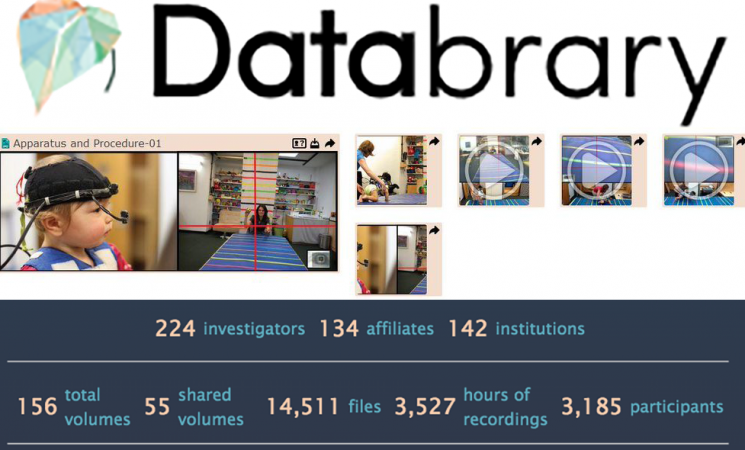Archived Content
This page is archived and provided for historical reference. The content is no longer being updated, and some of the information may have changed over time and could be outdated or inaccurate.

Human behavior is infinitely rich, and video is a great method for capturing it. But after the initial behavior of interest is scored, the analysis is completed, and the paper is published, video data is often relegated to lab “attic space,” gathering dust for the rest of its life. In a recent Behavioral and Social Sciences Research lecture, Dr. Karen Adolph discussed the many reuses of video and video sharing, and presented her Databrary project, which enables researchers to ethically share their video data.
Adolph’s lab studies infant behavior, and video is its main data collection method. The researcher shared a 30-second video clip of a baby playing with a toy, which captured the caregiver’s words and facial expressions, the baby’s facial expressions and movements, the social interaction, and the baby’s responsiveness. Although the video may have been recorded with a single research question in mind, the abundance of data in the clip suggests that many other research questions could be formulated from viewing it.
As Adolph pointed out, while behavior is fleeting, if captured on video many aspects become permanent, tangible, measurable, and analyzable. To illustrate her point, she shared an anecdote about how she once observed birds standing in shallow water. They were seemingly randomly distributed, but when it started raining, they all turned to face the same direction. While she was able to capture a photo after the birds had aligned themselves, she regretted not having captured the movement on video so that she could have seen the process by which they aligned.
Through her extensive experience using video data, Adolph had an important message to share with attendees: Video can be reused, both by the researchers who originally recorded it and by others to ask new questions beyond the scope of the original study. Additionally, data reuse and sharing increase scientific transparency and accelerate the pace of discovery.
Video can be reused by researchers and by others to ask new questions beyond the scope of the original study
Video Reuse
During her lecture, Adolph offered an example that illustrated how the reuse of her own video data enriched her research. She had taken 100 hours of video of 50 infants when they were 11 and 13 months old. Initially, she had set out to explore whether an infant’s transition from crawling to walking changes its social interactions with its mother. She found that while crawling babies most often try to share objects from a stationary position and only rarely bring the object to the mother, walking babies readily shared objects from both a stationary position and by walking an object to their mothers.
But Adolph’s team noticed interesting patterns as they coded the video. They saw that crawling babies carried different types of objects than walking babies, and they differed in terms of how far they were willing to travel to share an object. As a result of this discovery, Adolph and her team became interested in infant perception and motor skills in addition to social interaction, which had been their initial question.
But the team didn’t stop there. The videos also raised the question of whether mothers responded differently to babies who carried objects. They returned to the original video data and found that maternal responses when babies carried an object to them were quite different from maternal responses when babies shared objects from a stationary position. Overall, the ability to walk offered babies a different type of social interaction with their mothers. Adolph has also used the original videos to study infants’ locomotion, such as the number of steps, the distances covered, and the number of falls during free play.
@Databrary project is funded by NIH and NSF and enables video sharing and reuse among developmental researchers
Databrary and Privacy
Altogether, Adolph used her original videos to explore at least four different research questions, but she pointed out that videos are also valuable to other research groups. Adolph’s Databrary project is funded by the NIH and National Science Foundation and enables video sharing and reuse among developmental researchers. With video sharing, the output of a particular dataset or group of videos no longer depends on the interests and analyses of only one research group. Instead, Adolph pointed out that a shared dataset would be subject to the imaginations of many researchers with different research interests and areas of expertise.
Common de-identification practices defeat the purpose of using video data, but video sharing is still possible
Theoretical benefits aside, what about privacy? Video captures faces, names, and sometimes the places where subjects live or go to school. Adolph says that while de-identifying videos is not practical because common de-identification practices—such as blurring faces—defeat the purpose of using video data, video sharing is still possible. Databrary makes video sharing permissible with two measures. First, Databrary restricts access to its videos. Users must hold principal investigator status at a university or other institution, have undergone human subjects and ethics training, and be governed by an Institutional Review Board. Access to Databrary data is formalized with an institutional agreement. Second, the informed consent process is extended to include a second consent in addition to the one required to participate in the study; it seeks consent for data sharing and is obtained (or not) independently from the consent to participate in the study.
Adolph’s overall message is clear: Video is a rich source of behavioral data and can be shared ethically to maximize its usefulness.








